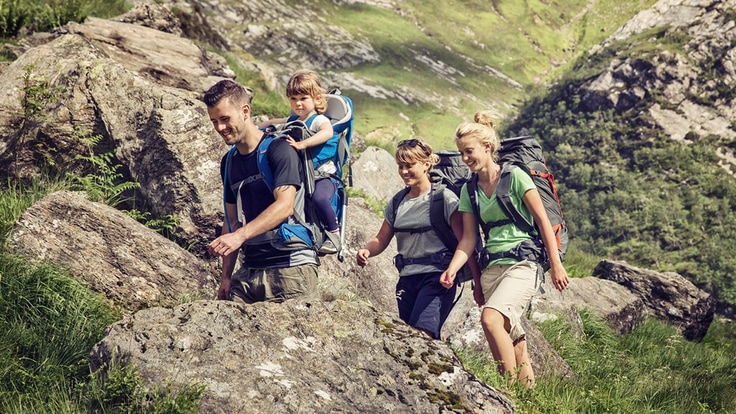If your love of the outdoors has recently been superseded by a new love—your newborn baby—don't worry. With the right gear, you can all live together happily ever after. This article will give you the basics on how to shop for a trail-worthy child carrier:
- When baby will be ready
- Key features to consider
- Getting the right fit for you and your baby
- Tips to help you maximize your fun together
When Is Your Baby Ready for a Child Carrier?
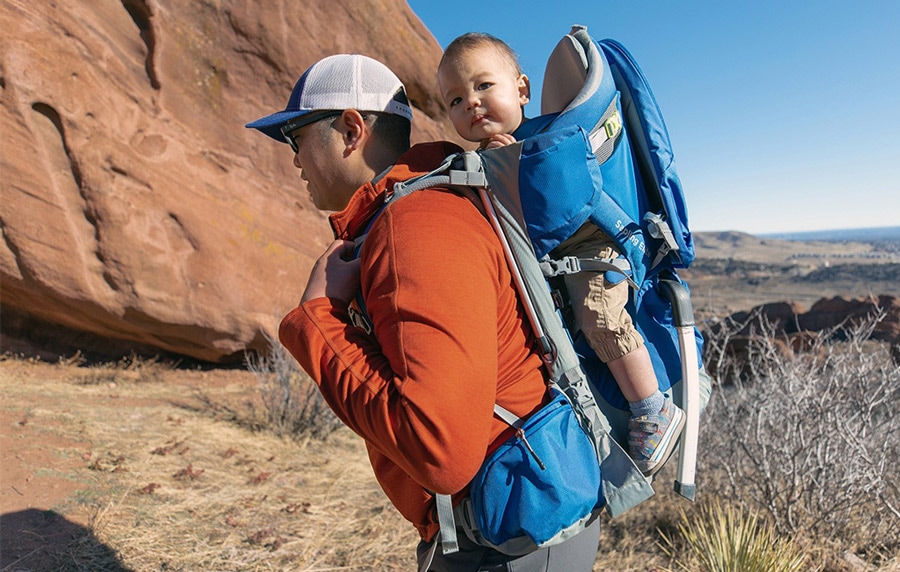
For starters, your newborn isn't ready for a full-size child carrier. You'll need to carry her or him in an infant carrier: typically, a frameless sling that snuggles baby in front of you.
Graduating to a Child Carrier
The child carriers you find at REI Co-op have a built-in frame that holds the child behind you. Your child needs to be at a certain stage of development, but not too big:
- Make sure your child can sit upright without assistance.
- Kids who are at least 16 lbs. (6 months or so) are good candidates, as long as they have full head and neck control.
- Ask your pediatrician to confirm that your child can ride in a carrier.
- Make sure your child plus the gear in the pack weighs no more than 48 lbs.
Activities You Can Do with a Child Carrier
The fact that child carriers are made by backpack companies makes it no surprise that these are the main uses:
- Hiking
- Backpacking
- Traveling
- Walking around town
Activities You Shouldn't Do with a Child Carrier
Because the added weight and movement of your child could cause you to lose your balance, child carriers aren't recommended for the following activities:
- Hiking on loose rock
- Trail running
- Climbing
- Skiing
- Skating
- Biking
- Any high-speed activity
Child Carrier Key Features
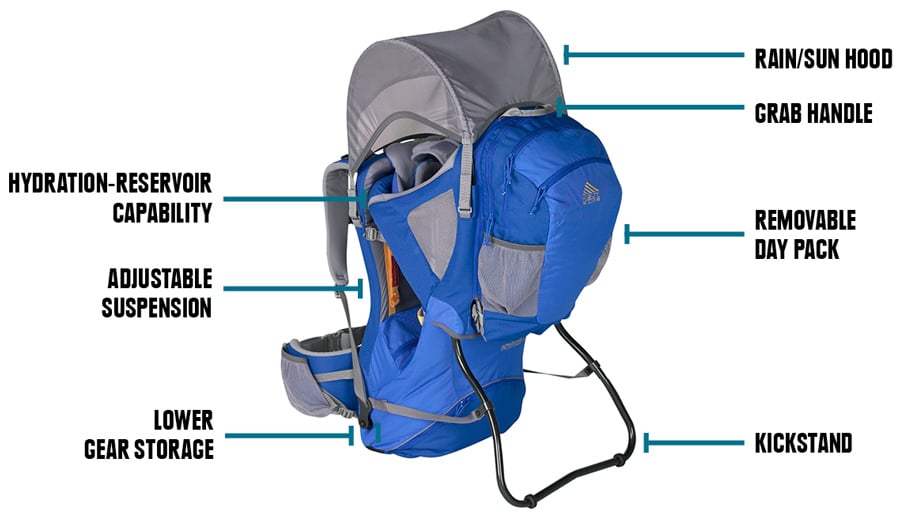
Most child carriers share basic features such as adjustable shoulder and waist straps, adjustable child harness, a kickstand and a sturdy frame.
Here are key features to consider:
Suspension system: Key to parental comfort, most carriers feature an easy-to-adjust ladder suspension, just like the suspension in many backpacks. Adjustable suspension is a must-have feature for parents who plan to trade off wearing the carrier.
Suspension adjustability is measured by the torso range spec. You can come into an REI pack department to get your torso range measured, or you can read how to do it at home in our Backpacks: Sizing and Fit article.
Kickstand: This bar helps create a stable base for loading and unloading your child. Most kickstands can be easily extended and retracted, and are designed to avoid pinching fingers when you retract them.
Frame: A sturdy, lightweight frame of tubular aluminum provides the structure needed to carry the weight of a larger child. The frame also helps transfer the weight of the child and carrier onto your hips, which can more comfortably handle that weight.
Accessories: If you plan on using a child carrier only occasionally, you might not want lots of bells and whistles. But if you plan to head off-road or carry lots of gear, consider models with the following extras:
- Gear-storage capacity, including removable diaper bags or day packs
- Diaper-changing pad
- Hydration-reservoir compatibility
- Stash pockets, including mesh pockets that are handy for a water bottle
- Removable rain/sun hood (sometimes sold separately)
- Removable bug netting (usually sold separately)
Weight and Price
Having a lot of added features and added cargo capacity makes a carrier both heavier and more expensive. So be realistic about how much stuff you plan to carry and whether you truly need certain accessories. Carrier weight inevitably affects carrying comfort, too: A pound or so of difference will be noticeable.
Fitting the Child Carrier to You and Your Child
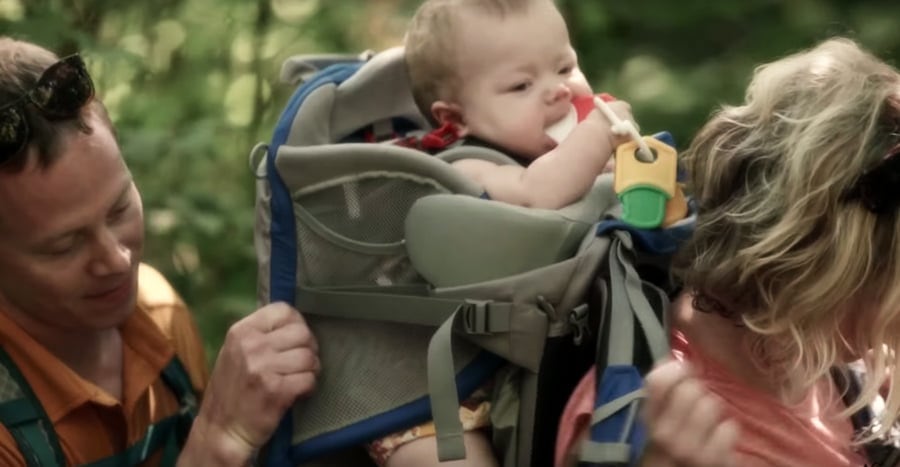
Fitting the Carrier to You
First, adjust the child carrier to fit you. You can have this done in an REI pack department, or do it at home. When making your initial adjustments at home, weight the pack with heavy items like books, rather than using your child.
- Adjust the suspension system to fit your torso, so that the hipbelt rests on your hip bones (not your waist) and the shoulder straps rest on your shoulders.
- Tighten the hipbelt so roughly 80 percent of the weight is on your hips.
- Tighten the shoulder straps so the child carrier is stabilized and the remaining 20 percent or so of the weight is on your shoulders.
- Tighten the load-lifter straps (running from the top of the shoulder straps toward the top of the back panel). They should be at roughly a 45-degree angle. If you see a gap between your shoulder straps and the top of your shoulders, loosen the load lifters and try again.
- Adjust the sternum strap across your chest so that it doesn't interfere with your breathing.
Fitting the Carrier to Your Child
Before putting your child in the carrier, adjust the height of the child seat. Make sure the child's straps are loosened and the kickstand is fully extended.
- Put your child in the carrier, making sure the feet slip through the leg openings.
- Buckle and tighten all straps, including the hipbelt, shoulder straps, leg strap adjustments and sternum strap. Note: Not all child carriers have all of these strap options.
- Tighten the side compression straps, if available.
- Check the seat height—your child's chin should be roughly level with the top of the chin pad.
- Check to make sure the child's shoulder straps fit smoothly over the shoulders and that the leg straps are comfortable.
Putting On and Taking Off Your Carrier
Lifting your child in your carrier is similar to hoisting a heavy backpack. The first few times you do so, have someone help you put it on your back. The steps:
- Lift the child carrier by the top handles.
- Slip on the shoulder straps and buckle the hipbelt.
Read How to Pack and Hoist a Backpack for more lifting tips for any heavy pack.
When removing the carrier:
- Loosen the shoulder straps and unbuckle the hipbelt.
- Grab the handle behind your head and bring the carrier around to your front
- Grasp the second handle to help you set the child carrier on the ground.
Tips on Using a Child Carrier
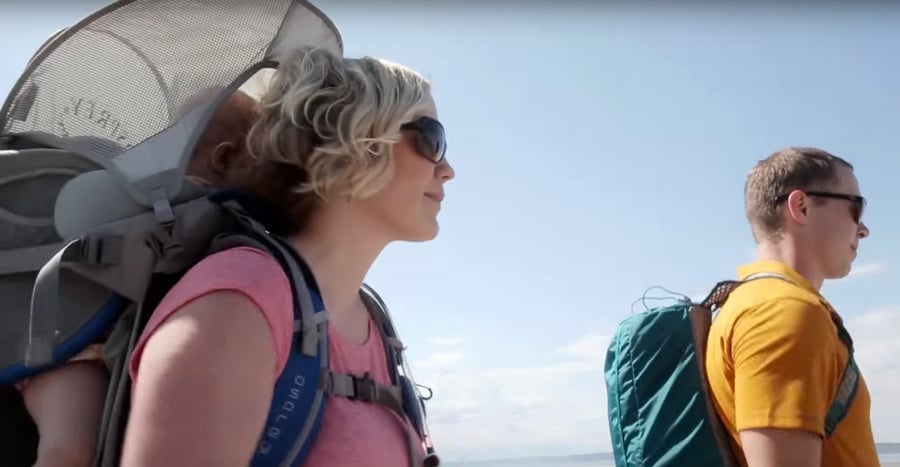
- Don't leave your child unattended while he or she is in the child carrier.
- Children tend to fall asleep, so check your child's neck support and comfort periodically.
- Child carriers aren't adequately stable to be used as a chair, nor should they ever be placed on elevated surfaces such as a bench, table or bed.
- Do not use a child carrier if the frame or fasteners are damaged.
- Make sure your child is not too warm, not too cold, your child is fully protected from the rain, wind and sun.
- To avoid a choking hazard, do not let your child eat while riding in the carrier; wait until you can monitor snack time at a rest stop.
- You can clip a toy to your carrier (make sure your clip setup is free of choking hazards) to help keep your child engaged; don't pick a sentimental favorite, though, in case your little Houdini frees, then drops it.
